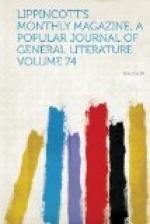to our eyes of the incidents of our Saviour’s
life, especially His passion, gives them more reality
than even the most frequent reading of the Bible.
This renders the crucifixion extremely painful, intolerable
in powerful pictures. I knew of an intelligent,
sensitive little child who burst into convulsive sobbing
before Tintoretto’s great Crucifixion in the
Scuola San Rocco at Venice. In the Belvedere
at Vienna there is a picture by Rubens of the dead
Christ in the arms of the usual small group: His
mother is removing with a light, tender touch a thorn
which is still piercing the cold brow. The whole
picture is in the same spirit, and I never could look
at it with dry eyes. Yet in Rubens’s hands
this and all kindred subjects are generally repulsive.
The very early masters are prone to fix the attention
upon some revolting detail of torture or too material
and agonizing exhibition of physical suffering, but
their stiff, hard outlines, absence of perspective
and childishness of composition, with the element
of the grotesque which is seldom absent, take the
edge off their effect. Later, when art has advanced,
and is capable of affecting us more deeply, refinement
too has advanced: there is less simplicity, but
merely painful detail is subordinated to general expression
and skill of drawing and color. It is where the
two meet, as in Rubens, that the result is most harrowing:
the picture I have just spoken of is the only one
of his in which I ever saw any sign of delicacy or
tenderness, any appeal to the deeper and more exquisite
emotions. Nevertheless, by degrees his genius
helps one to surmount his realism. On my first
visit to Antwerp I looked for a few minutes—which
was as long, as I could bear it—at the great
Descent from the Cross in the cathedral, and turned
away with the conviction that I could never have anything
but distressing and disagreeable impressions from
that picture. Six months afterward I was in Antwerp
again: I could not see the Descent often enough,
and spent my last hour in the place before it.
Yet he is a brutal painter withal, and such subjects,
however magnificently treated by him, could never give
me the same unmixed enjoyment as in the hands of the
gentle and pensive Vandyke.
Some people maintain that all great works of art speak
for themselves, and will make their appeal at once
to a person capable of appreciating them, without
any previous experience or education. This is
impossible, for were it so the fine arts would be an
exception to the rules which govern everything else
in life—music, literature, moral beauty
and the beauties of Nature. It must be with them
as with other things: knowledge, cultivation,
practice enhance the power of enjoyment. Of course,
in this, as in all matters, individual organization
will tell powerfully; but take an intelligent, educated
person of average perceptions, who has never seen a
single good picture, and set him before one of the
greatest in the world, and I doubt if he would receive




